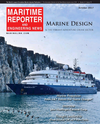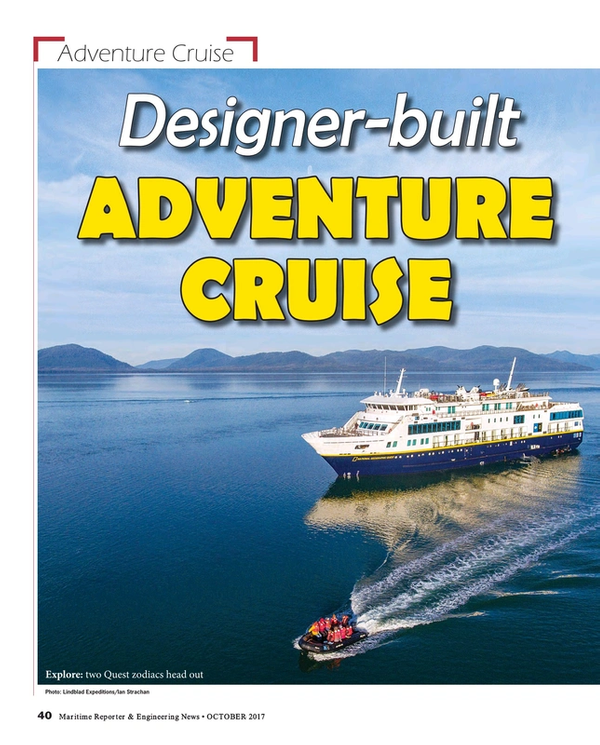The 2016 Polar Code has its first luxury-adventure cruise adherents for the long, new ice-free seasons in the high latitudes. Likewise, many designs winning over owners and explorers target exotic Asia-Pacific destinations. Competition is fierce among “designer-shipyards” seeking to build their designs, but their creations could face fewer hurdles to construction than the designs of independents without a yard. Concepts bound for the slipway have something else in common: new davits for large numbers of water craft.
“In addition to our nine shipyards, the Vard group of companies comprises specialized subsidiaries that focus on particular areas of expertise,” Vard business development manager, Holger Dilling, tells us about Vard Design, Vard Electro and Vard Accommodation for HVAC. “In the cruise segment, we can draw on expertise in the wider Fincantieri Group.” They’re competitive words. Not far away, another of Norway’s famous shipyards, Ulstein, has been pouring on the pressure with adventure cruise designs of its own.
Vard was first out, obtaining interest last year from Hapag-Lloyd Cruises of Germany and French cruise company Ponant for two builds: now, a contract for the design and construction of an expedition cruise vessel for Australia’s Coral Expeditions. Despite the in-house knowhow, Dilling says not all suppliers for the Coral project have been decided on.
Ulstein’s adventure cruise concepts have long been drawn-up. Now, “in the nick of time” — in their 100th year — the X-bow’s proponents have secured an order with China Merchants Group Shipyard for Chinese tour operator and ship ower, SunStone Ships.
When it comes to cruise, however, both Norwegian yards have stiff competition paddling into a business stream expected to pick up the slack for stalled offshore markets. Yards like Portuguese WestSea (Martifer Group) or Nichols Brothers Boat Builders in North America are near or already out with designs of adventure vessels of their own. NBBB for Lindblad Expeditions, and WestSea with Rolls-Royce propulsion and power help on the MV National Geographic Quest. Then there’s Dutch shipbuilder Damen’s second sale of its 75-meter luxury expedition yacht for the tropics and the polar latitudes. “The SeaXplorer 75 stands out with not only a dive center and submersible hangar, but also a complete floating heliport for two aircraft,” a communique trumpets. Competition is serious in this segment, especially in and around 2,500 GT, but also up to 7,000 GT.
Then come talented designers like Monaco’s Stefano Patrovich, renderer of an adventure cruise vessel conversion concept for an out-of-work Norwegian offshore service vessel, or OSV. Norwegian news E.24 suggests cash-strapped Kleven yard could do the Patrovich OSV conversion.
“Niche segments offer new opportunity,” said DNV GL department head for cruise vessels, Bjorn Berger, before adding, “There’s (little building) capacity for new, smaller cruise vessels until 2025.” That was in 2016, but there’s still little yard capacity for smallish but complicated cruise concepts. Kleven, NBBB, Vard and Ulstein’s Chinese yard partner were among few yard slots available when the opportunity came. Big Cruise ships have the other spots occupied.
Class-Aware
Noteworthy among the other type of adventure cruise yard work to do is Ulstein’s refit in July 2017 of the older ship Ocean Adventurer for owner Adventurer Partners and cruise operator Quark Expeditions. This conversion of the Yugoslav-built ice-strengthened vessel from 1976 is a sign that newer adventure cruise vessels are needed to meet an IMO Polar Code that takes special aim at passenger safety and safe, clean operations.
“The existing (adventure cruise) market is very old vessels,” says Steven Sawhill, a principle consultant for DNV GL and a former U.S. Coast Guard Commander. “There’s an expectation that they’ll be renewed.” He confirms that passenger numbers to the (Arctic and) Antarctic have been going up steadily. In the Antarctic — fully-booked destination of the MS World Explorer designed by Giuseppe Tringalis and being built by WestSea Yard — the high-time for adventure tourism was “07’, 08’”, Mr. Sawhill says, adding that it’s surging again. Numbers dropped after the heavy fuel oil ban of 2011, but “2016-2017’” is a booming adventure-cruise year. He shows numbers indicating the number of tourists touching ground in the Antarctic this year will reach 32,000 versus 20,300 between 2011 and 2012! Slow year 2013 saw 86 passenger vessels in the Arctic alone, according to AIS data and Sawhill, a regular speaker at “various arctic shipping conferences.”
Davits Decisive
The key to easy passenger expeditions to wilderness areas are a vessel’s handling of RIBs, dinghies, kayaks, Zodiacs and waterjets. When Lindblad’s Quest brings adventure travelers in close for a personal view of nature’s wonders, a Vestdavit TSB-2500 davits will deploy its Zodiacs and kayaks astern and hoist these once passengers step back aboard ship via a small step. This 238-footer with 50 cabins and a twin-screw diesel engine will explore Baja, Costa Rica and Panama in winter and Oregon, Washington, Alaska and Canada in summer, so lots of water craft. Quest passengers will get closer to marine life via bow cams and the cameras of an onboard ROV. Quest, now on its maiden journey, will have a sister ship in spring 2018.
Interestingly, Bergen-based Vestdavit — a well-run, multi-million-dollar davits-producer — is opening an office in Seattle after success serving the offshore sector, the U.S. Navy, U.S.C.G, NOAA and now adventure cruise. A U.S. sales and after-sales office will be run by Magnus Oding who confirmed the delivery to NBBB. Produced in Norway, the company’s multiple-boat MissionEase handling system was shown for the first time at NorShip 2017 after tests aboard an offshore service vessel. Seen on a YouTube video depicting an X-bow hull, MissionEase allows boats to be moved safely and quickly on “cradles” — “even in high seas or during a vessel listing”. Boats and equipment feed to the davits for launch or stowage after retrieval. The system avoids overhead cranes and “slow” slinging procedures to overhead gantries in favor of the hydraulic cradles that move craft to stowage, maintenance, preparation or launch zones. “It links seamlessly with single-point davits” to deploy or recover boats from both sides of a vessel so one operator on a remote can “launch and recover the mission boat, including all on-deck handling.” The system seems made for the stable, dry environment of an expedition cruise vessel’s “mission (equipment) bay.”
Warmer Climes
Vard’s Coral order marks the cruise segment’s other focus areas — the tropics and the Asia-Pacific — also require “tailor-made solutions” for a customer’s cruise concept and destinations.
“VARD has entered into a firm contract for the design and construction of the vessel, so this one will definitely be built,” says Holling. Prior to the new contract, Vard had six luxury expedition cruise vessels under contract: four for PONANT and two for Hapag-Lloyd. Hoping to match that success, Ulstein’s quest for adventure cruise success has lead to the opening of a new design department in Norway’s marine research capital, Trondheim. In May, the Ulsteins penned a letter of intent for “at least one” CX104 expedition cruise vessel between Ulstein Verft, the builder, and an unnamed owner. Then came the Chinese seeking a 100m CX103.
When built, the CX104 design rendered by Ulstein Design & Solutions will be 120 m long and wrapped by an ice-class “belt” for “polar capability”. Delivery is set for 2019. The company has several CX designs, but only the 103 and 104 appear to be in our “adventure cruise” envelope due to their smaller size of 7,000 GT to 10,000 GT and stowage for adventure craft. Other Ulstein drawings show cruise vessels of from 17,000 GT to 25,000 GT.
The new contract with China Merchants Group to build a CX103 for their client SunStone includes an Ulstein design and an equipment package for one vessel and options for another nine ships. The SunStone CX103 expedition vessel is 104 metres long, 18 m wide and built to keep 255 passengers comfortable. Polar Code PC6 denotes Safe Return to Port and Virtual Anchorage, a nod to the new stricture’s focus on ice operations.
“(The Polar Code) is goal-based code. You can’t say what’s required because it demands … what a vessel can do or cannot do,” says Mr. Sawhill. So, the tour operator, perhaps, rather than Ulstein, will have to “define the activity, the hazards … the operational measures”. Leave it to Ulstein to “select (The Code’s) design measures”, is how we interpret it.
It’ll be interesting to see whether the extra X-bow space afore becomes “underwater observation lounges” or recreational areas “such as large cinemas”, rooms for kids or a spa.
More Sun
For experienced expedition cruise-ship builder Vard, the September 2017 pact with Coral to design and build a luxury expedition vessel shows the efficacy and the challenge of being a designer-yard versus just a designer. The 93.5 m VARD 6 01 design that’ll be built at Vard Vung Tau in Vietnam for early 2019 will have comfort for 120 adventurous travellers and an environment geared for daily shore expeditions and briefings on destinations that include the Great Barrier Reef, Papua New Guinea and South Pacific islands.
“Independent designers may propose concepts, but from there it is a long way to a complete project that can actually be realized,” Dilling said.



